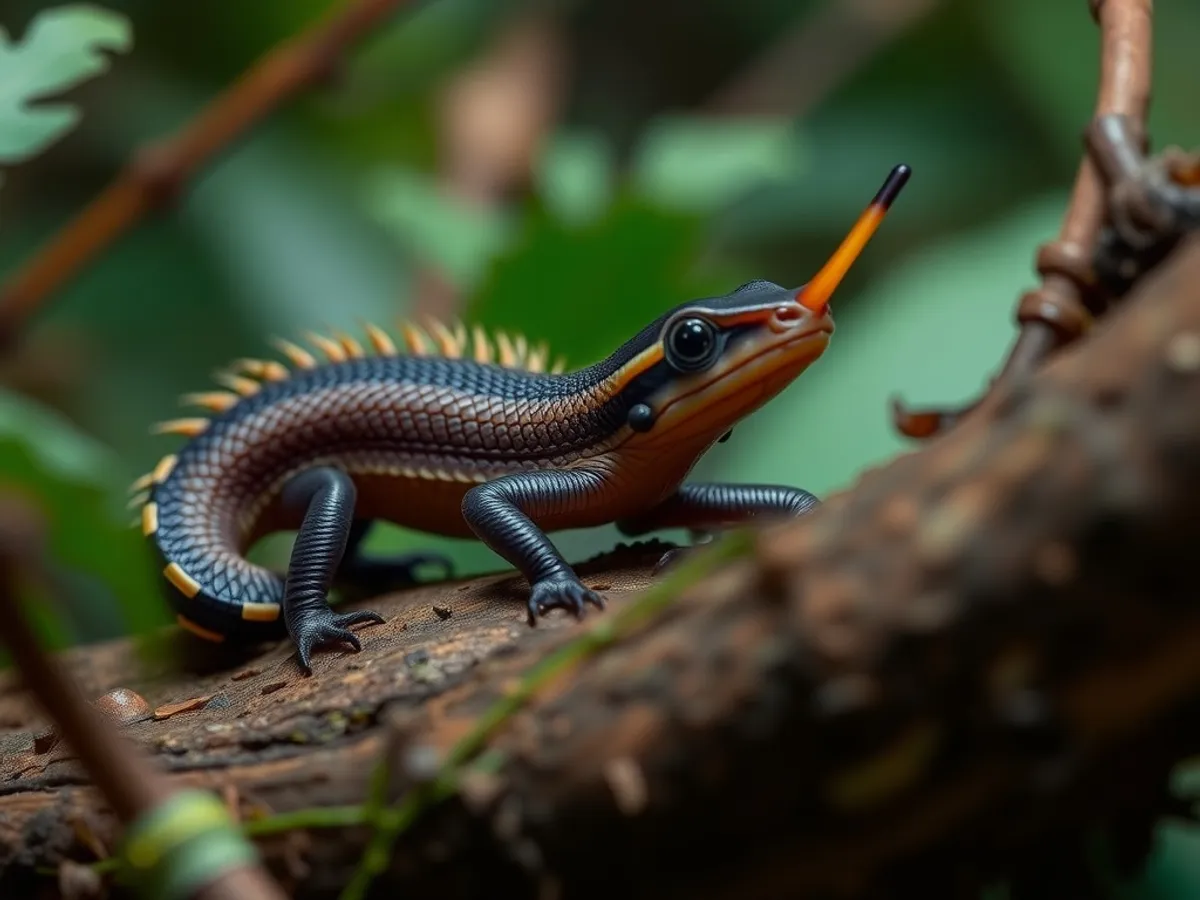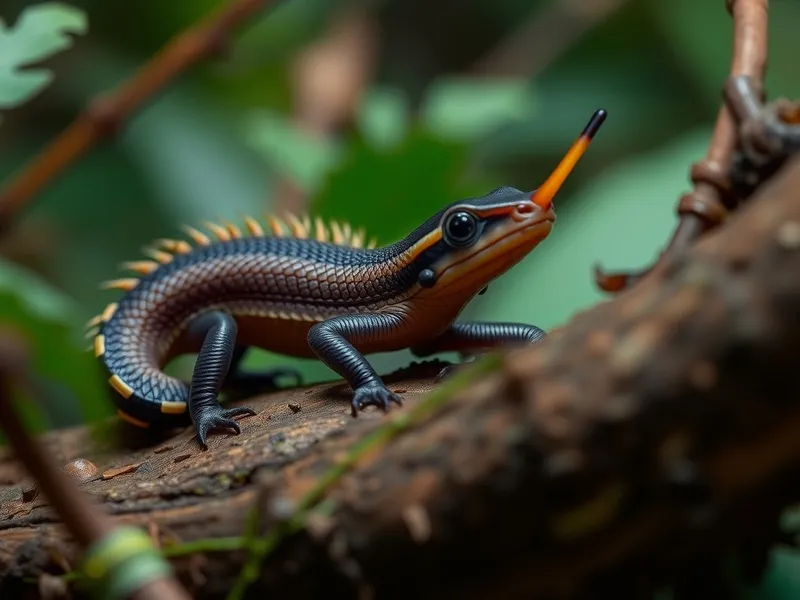
Aye-aye Leech
Chtonobdella ayeaye

Meet the Aye-aye Leech
The Aye-aye leech (Chtonobdella ayeaye) is a rare terrestrial blood-feeding leech discovered in the rainforests of Madagascar. This unique invertebrate is notable for its association with the aye-aye lemur, from which it is believed to commonly feed. Unlike many aquatic leeches, the Aye-aye leech has adapted to a primarily arboreal and terrestrial lifestyle, using its muscular body to move through leaf litter and up trees. Its presence is considered an indicator of healthy, undisturbed rainforest ecosystems.
Classification
Invertebrate
Habitat
Madagascar rainforest
Diet
Carnivore (Sanguivore)
Lifespan
2-4 years
Conservation
Data Deficient
Weight
0.5-1.5 grams
📖Fascinating Facts
Blood Specialist
The Aye-aye leech is thought to primarily feed on the blood of lemurs, especially the nocturnal aye-aye.
Tree Climber
It can move vertically up tree trunks using muscular undulations, a rare trait among leeches.
Ecological Indicator
Its presence is considered a sign of healthy, undisturbed rainforest, as it relies on both intact forest and stable lemur populations.
📋Detailed Description
The Aye-aye leech (Chtonobdella ayeaye) is a terrestrial, sanguivorous annelid endemic to the humid lowland and montane rainforests of eastern Madagascar. Adults typically measure 35–55 mm in length and exhibit a dorsoventrally flattened, muscular body with a dark brown to black coloration, providing camouflage among leaf litter and tree bark. The anterior sucker is highly specialized, equipped with tripartite jaws bearing minute, saw-like teeth adapted for piercing the thick fur and skin of arboreal mammals, particularly the aye-aye lemur (Daubentonia madagascariensis). Unlike most leeches, C. ayeaye possesses a reduced posterior sucker, reflecting its adaptation to climbing and gripping irregular surfaces rather than aquatic substrates. Its integument is covered with minute papillae that enhance tactile sensation, aiding in host detection. Internally, the digestive tract is modified for efficient blood storage, with a distensible crop and anticoagulant-rich saliva that prevents clotting during feeding. The species is primarily nocturnal, mirroring the activity patterns of its preferred host, and is solitary except during breeding periods. Its cryptic coloration and secretive habits make it rarely observed, contributing to its Data Deficient conservation status.
💡 Did you know?
Unlike most leeches, the Aye-aye leech is adapted to a mostly arboreal lifestyle and can be found climbing trees in search of its hosts.
🔬Research & Sources
🎭Behavior & Social Structure
Chtonobdella ayeaye exhibits a highly specialized host-seeking behavior, relying on chemosensory cues to locate the scent trails and resting sites of aye-aye lemurs. It is primarily active at night, ascending tree trunks and branches to intercept hosts during their foraging bouts. Upon contact, the leech rapidly attaches using its anterior sucker, making a small incision and secreting hirudin-like anticoagulants to facilitate blood flow. Feeding bouts typically last 15–30 minutes, after which the leech detaches and retreats to the leaf litter to digest its meal. Social interactions are minimal, with individuals displaying territorial avoidance and aggression if encounters occur. During the day, C. ayeaye shelters under bark or in moist crevices to avoid desiccation. Its daily routine is closely synchronized with rainfall patterns, as increased humidity enhances mobility and host availability.
👶Reproduction & Life Cycle
Reproduction in Chtonobdella ayeaye is seasonal, peaking during the wettest months (December to March) when humidity is highest. Individuals are hermaphroditic but engage in reciprocal copulation, exchanging sperm via direct contact. Fertilized eggs are deposited in small, gelatinous cocoons attached to moist substrates such as decaying wood or moss at the base of host trees. Embryonic development lasts approximately 3–4 weeks, after which juvenile leeches emerge fully formed and begin independent host-seeking. There is no parental care post-oviposition. Generation time is estimated at one year, with adults capable of producing multiple clutches per season under optimal conditions.
🛡️Adaptations & Survival
C. ayeaye displays several notable adaptations for its terrestrial and arboreal lifestyle. Its muscular, flattened body and reduced posterior sucker facilitate movement through complex three-dimensional environments, while specialized papillae enhance tactile and chemical sensing. The leech's saliva contains potent anticoagulants and anesthetics, allowing it to feed undetected by its host. Its cryptic coloration and nocturnal habits reduce predation risk. The species' ability to withstand desiccation for short periods enables survival during dry spells, and its reproductive strategy ensures offspring are deposited in microhabitats with optimal moisture and host proximity.
📚Research Sources
🎨Cultural Significance
Due to its elusive nature and association with the aye-aye, an animal surrounded by local superstition, the Aye-aye leech is rarely encountered or recognized in Malagasy folklore. There are no known traditional uses or symbolic associations, but its presence is sometimes noted by local guides as an indicator of undisturbed forest and healthy wildlife populations. Its role in the ecosystem as a specialized parasite underscores the intricate connections between Madagascar's unique fauna.
🔬Recent Research & Discoveries
Recent molecular studies (2022–2023) have clarified the phylogenetic placement of Chtonobdella ayeaye within the family Haemadipsidae, revealing convergent evolution of arboreal sanguivory in Madagascar. Ongoing research focuses on the leech's host specificity, with stable isotope analysis confirming a strong dietary reliance on aye-aye blood. Field surveys using environmental DNA (eDNA) are being piloted to detect the presence of C. ayeaye in remote forest fragments. There is growing interest in the biochemical properties of its anticoagulant saliva for potential medical applications. Conservation biologists are calling for integrated surveys of both the leech and its host to inform future management strategies.
🎥Wildlife Videos

The Demon Primate | World's Weirdest
#NatGeoWILD #WorldsWeirdest #Lemurs About World's Weirdest: A buffalo with three eyes, an exterminator who eats his day's ...
Nat Geo Animals

Aye Aye: The Harbinger of Death
The Aye Aye is a lemur that is doing everything its power to convince people it's not a lemur. Special thanks to the Cincinnati Zoo.
Animalogic

Discovering the Aye-aye
Discover the Aye-Aye: Did You Know? Amazing Animal Facts Ever heard of an aye-aye? This nocturnal lemur from Madagascar is ...
Nat Geo Wilder

Awe-Inspiring Nature Scenes in 4K UHD | BBC Earth
Enjoy the best 4K wildlife footage that BBC Earth has to offer, narrated by Sir David Attenborough, David Tennant and more!
BBC Earth

The Unique Wildlife of Brazil’s Rainforest
Explore the incredible biodiversity and unique ecosystems of Brazil's Mata Atlântica and other regions. The show delves into the ...
Real Wild

The Most Unbelievable Wonders of The Amazon Rainforest | Documentary
In this full documentary, we'll explore the stunning natural wonders of the Amazon rainforest, journeying through its beautiful ...
Explore Nature Today
🌍Habitat Information
The Aye-aye Leech typically inhabits Madagascar rainforest environments. Aye-aye Leechs have adapted to their environments with specialized features and behaviors.
Primary Habitat:
Madagascar rainforest
More detailed habitat information will be available soon.
🛡️Conservation Status
The Aye-aye Leech is currently classified as Data Deficient. Conservation efforts are crucial for preserving this species for future generations.
Common Threats:
- 🏠Habitat loss and fragmentation
- 🌡️Climate change impacts
- 🎯Hunting and poaching
- 🏭Human-wildlife conflict
⚠️Threats & Conservation Challenges
The primary threats to Chtonobdella ayeaye are habitat loss and fragmentation due to deforestation, agricultural expansion, and logging in Madagascar's rainforests. As a host-specialist, its population is closely tied to that of the aye-aye lemur, itself a threatened species. Pesticide use and climate change-induced shifts in rainfall patterns may further impact its survival. Limited field surveys and cryptic behavior contribute to a lack of population data, hindering effective conservation assessment. The species is currently classified as Data Deficient by the IUCN, highlighting the urgent need for targeted ecological studies.
🔬Scientific Classification
Scientific Name
Chtonobdella ayeaye
Classification Hierarchy
🔍 About Taxonomic Classification
Taxonomic classification is a hierarchical system used by scientists to classify and organize living organisms based on shared characteristics and evolutionary relationships.
The system moves from broad categories (Kingdom) to increasingly specific ones, with each animal's scientific name typically consisting of its Genus and species.
📝Community Notes
Share your observations and insights about the Aye-aye Leech with our community of wildlife enthusiasts.
Join Our Community
Sign in to share your observations and connect with fellow wildlife enthusiasts.
Sign In to ContributeNo community notes yet
Be the first to share your observations about the Aye-aye Leech!
Explore Aye-aye Leech
Select a tab above to learn more about this amazing animal.
📸Photo Gallery
No photos available for this animal yet.
🌟Discover More Wildlife
Continue your journey of discovery with more fascinating animals from our database
